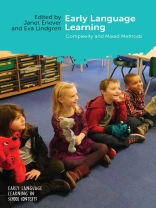This is the first collection of research studies to explore the potential for mixed methods to shed light on foreign or second language learning by young learners in instructed contexts. It brings together recent studies undertaken in Cameroon, China, Croatia, Ethiopia, France, Germany, Italy, Kenya, Mexico, Slovenia, Spain, Sweden, Tanzania and the UK. Themes include English as an additional language, English as a second or foreign language, French as a modern foreign language, medium of instruction controversies and content and language integrated learning (CLIL). The volume reviews the choice of research methodologies for early language learning research in schools with a particular focus on mixed methods and proposes that in the multidisciplinary context of early language learning this paradigm allows for a more comprehensive understanding of the evidence than other approaches might provide. The collection will be of interest to in-service and trainee teachers of young language learners, graduate students in the field of TESOL and early language learning, teacher educators, researchers and policymakers.
Daftar Isi
Dedication
List of Contributors
List of Figures
List of Tables
1. Eva Lindgren and Janet Enever: Introduction: Mixed Methods In Early Language Learning Research – Examining Complexity
SECTION 1. OVERVIEWS OF RESEARCH FINDINGS
2. Agatha J. Van Ginkel: Early Language Learning in Complex Linguistic Settings, Insights from Africa
3. Patricia Driscoll: The Complexity of Cultural Learning within Early Language Learning: A Model of Good Practice
4. Victoria Murphy: Literacy Development in Children with English as an Additional Language (EAL)
SECTION 2. EMPIRICAL STUDIES USING MIXED METHODS
5. Alison Porter: Verbal Working Memory and Foreign Language Learning In English Primary Schools: Implications for Teaching and Learning
6. Jiang Changsheng, Zhang Jie, Liang Xiaohua, Yuan Yuan and Qun Xie: Piecing Together the Jigsaw: Understanding Motivations of English Learners in Chinese Primary School through a Questionnaire and Elicited Metaphor Analysis
7. Judith Buendgens-Kosten, Ilonca Hardy and Daniela Elsner: Code-Switching Your Way to Language Learning? Receptive Code-Switching With Digital Storybooks in Early Language Learning
8. Heather Hilton: Individual Differences and English L2 Learning in Two Primary Classrooms in France
9. Karmen Pižorn: Content and Language Integrated Learning: A Panacea for Young English Language Learners?
SECTION 3. LONGITUDINAL PERSPECTIVES USING MIXED METHODS
10. Yuko Goto Butler: The Dynamics of Motivation Development among Young Learners of English in China
11. Lucilla Lopriore: Young Italian Learners’ Foreign Language Development: A Longitudinal Perspective
12. Eva Lindgren and Janet Enever: Employing Mixed Methods for the Construction of Thick Descriptions of Early Language Learning
13. Jelena Mihaljević Djigunović: Developmental Aspects of Early EFL Learning
SECTION FOUR: EVALUATING EARLY LANGUAGE LEARNING PROGRAMMES
14. María Del Pilar García Mayo and Ainara Imaz: Child EFL Interaction: Age, Instructional Setting and Development
15. Peter Sayer, Ruth Ban and Magdalena López De Anda: Evaluating the Educational Outcomes of an Early Foreign Language Program: The Design of an Impact Study for the Primary English Program in Mexico
16. Raphaela Porsch and Eva Wilden: The Development of a Curriculum-Based C-Test for Young EFL Learners
17. Janet Enever and Eva Lindgren Mixed Methods in Early Language Learning Research
Tentang Penulis
Eva Lindgren is Professor of Language Teaching and Learning at Umeå University, Sweden.












